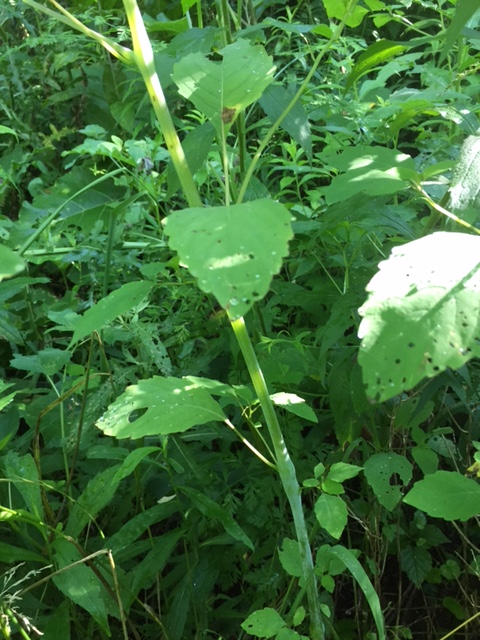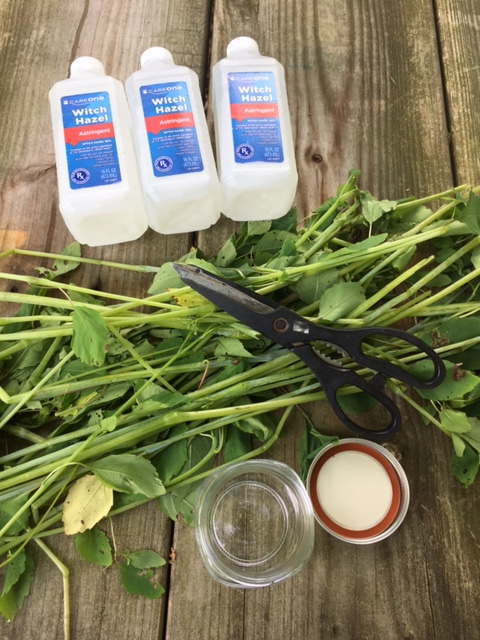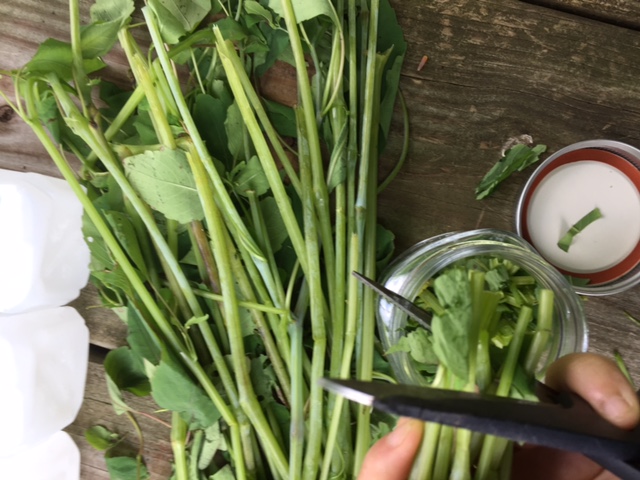As I spend copious time in the outdoors, I often end up covered with poison ivy at least once or twice in the summer. I happen to like poison ivy as a plant a lot–she is beautiful, she is powerful, and she teaches us awareness (more on her soon). But the contact dermatitis that I get from her on a regular basis kind of sucks. Given that, I have a simple recipe that I make and keep on my shelf that seeks the healing power of two other plants: witch hazel and jewelweed. This jewelweed-infused witch hazel is a great remedy for poison ivy and clears it up very quickly.
If you can’t find jewelweed, I believe this recipe would be fairly effective with plantain or chickweed. But Jewelweed is really the best.
Harvesting Jewelweed
Jewelweed (Impatiens capensis) is also known as spotted touch-me-not, orange touch me not, and orange balsam. It is an annual plant that self-seeds readily, so once you know where it grows, you can easily find it in the same spot year after year. It prefers damp, shady, forested environments, although I’ve also found it in wetter part sun or mostly sun environments. The key is that it likes a moist forest floor.

On a recent plant walk, one of my attendees told me that jewelweed was named this way because if you put it underwater in a flowing stream, it looks like a beautiful jewel! So try it and see if you agree.
This plant’s primary use in herbal medicine is as a poison ivy remedy. You can use it in two ways:
- Fresh jewelweed can be applied to a location that was just exposed to poison ivy. For this, simply pick a plant (especially getting the lower stem area and the places where the leaves join the stem that are very juicy), crush it, and rub it on the affected area. This may take off the oils from poison ivy and prevent you from getting contact dermatitis also known as poison ivy.
- You can pick it and tincture it in witch hazel (or vinegar, in a pinch) and use this to dry out and soothe the poison ivy.

If you are taking the remedy, you will need enough jewelweed (chopped up and crushed) to loosely fill a mason jar of whatever size you want to make. Unless you are in poison ivy all the time, probably a pint or half-pint jar is all anyone needs for a while. It does keep indefinitely, so it doesn’t hurt to make more.
I also like to leave an offering (a pinch of home-grown tobacco) for the jewelweed for the harvest, of course, to honor the plant and the land.
Making Your Poison Ivy Remedy
Poison Ivy on the skin is caused by the oils in the plant reacting with the skin. This makes the skin blister up and get very itchy. The more you scratch, you the more spread the poison ivy (by spreading the oils) all over your skin. What this remedy does is help heal and take out the itch (jewelweed) and dry out the afflicted areas (witch hazel). It works wonderfully.
Ingredients and Materials:
Scissors or a knife
1 bottle of witch hazel (you can make your own from the witch hazel plant by distilling the branches in the early spring or you can go to the drug store and pick some up)
5-10 jewelweed plants (depending on how much you want to make)
1 mason jar

Step 1: Crush up your jewelweed.
To make your preparation, you will want to get as much juice from the jewelweed as possible into your preparation. To do this, I like to first crush the jewelweed with my hands or a blunt object. I don’t crush it too much, but enough that it will expose more surface area to the witch hazel. Pay attention to the thicker areas where the leaves attach to the stem–these are very juice-filled (and the juice is the medicine).

Step 2: Chop up jewelweed finely into the jar.
Chop up (or tear up) the jewelweed and add it to the mason jar. A good pair of kitchen scissors will help this process quite a bit–I find that better than any knife for this work. You don’t want to over-fill the jar, but do fill it up loosely.

Step 3: Crush it some more in the jar.
At this point, I continue to crush the jewelweed. Here, I used my fingers, but I could easily use a pestle (the round thing used to grind herbs in a mortar) or some such similar tool. Get as much juice out as you can at this stage.

Step 4: Add witch hazel.
Now, pour in your witch hazel, ensuring that it covers the Jewelweed fully. If the jewelweed is too firmly packed, you’ll end up with less (after you remove the plant material in a few weeks).

Step 5: Lit sit (macerate) 2-3 weeks and then strain.
Let your preparation sit for a few weeks in a cool, dark place. Then, you can strain out the jewelweed (you can do this by hand, or with a handheld potato ricer or tincture press). Place the liquid back in the jar, ensuring that you don’t have any extra plant material.
Using your Jewelweed Infused Witch Hazel
You can use the jewelweed-infused witch hazel when you have an active outbreak of poison ivy dermatitis. Use a Q-tip or cotton ball and liberally apply the preparation to the affected area. Repeat this several times a day (or more, I usually do it 5-6 times a day or any time I enter the bathroom). It will clear up the poison ivy very quickly!
I hope this small remedy helps many a forest wanderer this summer!




Reblogged this on Paths I Walk.
Reblogged this on hocuspocus13 and commented:
jinxx🌿xoxo
Reblogged this on Rattiesforeverworldpresscom.
Thank you! I can attest to the healing powers of jewelweed, but did not know to mix it with witch hazel! Some years ago, my late husband, a doctor and organic gardener, made jewelweed poultices for my legs which had gotten a bad case of poison ivy dermatitis. It took a few days, but the areas healed much more quickly than with any other lotion or potion, and left no scarring! plus the jewelweed is beautiful!
Fresh poultices are the best, for sure! But I do like my witch hazel infusion. Plus, witch hazel is a great tree itself, so I like to put its medicine to work :).